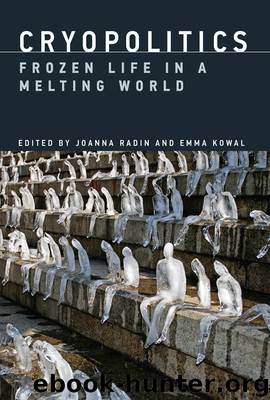Cryopolitics by Radin Joanna; Kowal Emma; & Emma Kowal

Author:Radin, Joanna; Kowal, Emma; & Emma Kowal
Language: eng
Format: epub
Publisher: MIT Press
Published: 2017-04-21T04:00:00+00:00
Third Critique: Genomic Indigeneity Is an Inadequate Form of Indigenous Resistance to the Death Narrative
Genomic indigeneity is produced from the analysis of preserved samples extracted from populations defined by scientists as of particular value owing to their geographic and cultural isolation, and in particular, their longevity in particular environments. The population geneticists who developed this mode of knowledge production often regarded indigenous people as frozen in time or relics of the past (Radin 2013). Scientists’ valorization of deep connections to place overlap partially with indigenous groups’ own articulations of peoplehood, although indigenous people’s co-constitutions with place are not fully accounted for in genome science accounts. Indigenous peoples do emphasize their long-standing relations to place, but in ways that differ significantly from many genome scientists. What differentiates the accounts of indigenous peoples is that they emphasize complex forms of relatedness of peoples and nonhumans in particular places. We might say, in the parlance of science and technology studies (STS), that indigenous peoples consider identity to be the product of a co-constitution of human and nonhuman communities while human genome diversity focuses predominantly on the movements of human populations through landscapes to populate the world (Reardon 2001; Jasanoff 2004; Latour 1999).
To be sure, the impact of environmental factors on the selection and mutation of genetic markers figure in decisive ways in genomics. However, as human genomic markers made to stand for “populations” are narrated as moving along ancient continental “migratory” routes, human agency upon the land and linear migratory narratives through time and space are still foregrounded over deep human–nonhuman relations in place. Contemporary “admixed populations,” in such a figuration, come to be conceived of as the descendants of indigenous “founder populations.” The primary agents in such narratives are abstracted human bodies and populations that are retrospectively modeled as biologically reproducing themselves along a linear path through time and space.
The dismissal by nonindigenous thinkers of indigenous origin stories in place, I argue, is not simply the result of privileging scientific evidence over indigenous creationism and rejecting “religious” accounts broadly. Such dismissals also ignore the importance of indigenous peoples’ emphasis on land-human co-constitutive relations. For example, when indigenous peoples push back against scientific narratives of indigenous Americans’ genetic “origins” in “Africa” or “Siberia,” indigenous peoples are not simply being antiscience. They may, in fact, be very interested in the science. At stake in contesting such genomic narratives is the desire of indigenous peoples to emphasize their emergence as particular cultural and language groups in social and cultural relation with nonhumans of all kinds—land formations, nonhuman animals, plants, and the elements in very particular places—their “homelands” or “traditional territories,” for example.
Furthermore, genomic indigeneity also fundamentally contradicts a definition of “indigenous” in its explicitly political formation. Indigenous peoples, in their networking between groups, have demonstrated that “indigeneity” can serve as an organizing category added to group-specific understandings. The concept “indigenous,” forged by delegates from communities around the world in transnational institutions like The Hague or the United Nations, helps individual communities articulate our collective resistance to the assimilative tendencies of the nation-state (Niezen 2003).
Download
This site does not store any files on its server. We only index and link to content provided by other sites. Please contact the content providers to delete copyright contents if any and email us, we'll remove relevant links or contents immediately.
| Anthropology | Archaeology |
| Philosophy | Politics & Government |
| Social Sciences | Sociology |
| Women's Studies |
Born to Run: by Christopher McDougall(6894)
The Leavers by Lisa Ko(6804)
iGen by Jean M. Twenge(5161)
Sapiens by Yuval Noah Harari(5122)
The Kite Runner by Khaled Hosseini(4952)
Spare by Prince Harry The Duke of Sussex(4786)
Bullshit Jobs by David Graeber(3830)
Machine Learning at Scale with H2O by Gregory Keys | David Whiting(3618)
Livewired by David Eagleman(3534)
Never by Ken Follett(3523)
Goodbye Paradise(3446)
Fairy Tale by Stephen King(2945)
A Dictionary of Sociology by Unknown(2852)
Harry Potter 4 - Harry Potter and The Goblet of Fire by J.K.Rowling(2801)
The Social Psychology of Inequality by Unknown(2763)
The Club by A.L. Brooks(2746)
People of the Earth: An Introduction to World Prehistory by Dr. Brian Fagan & Nadia Durrani(2619)
0041152001443424520 .pdf by Unknown(2592)
Will by Will Smith(2577)
